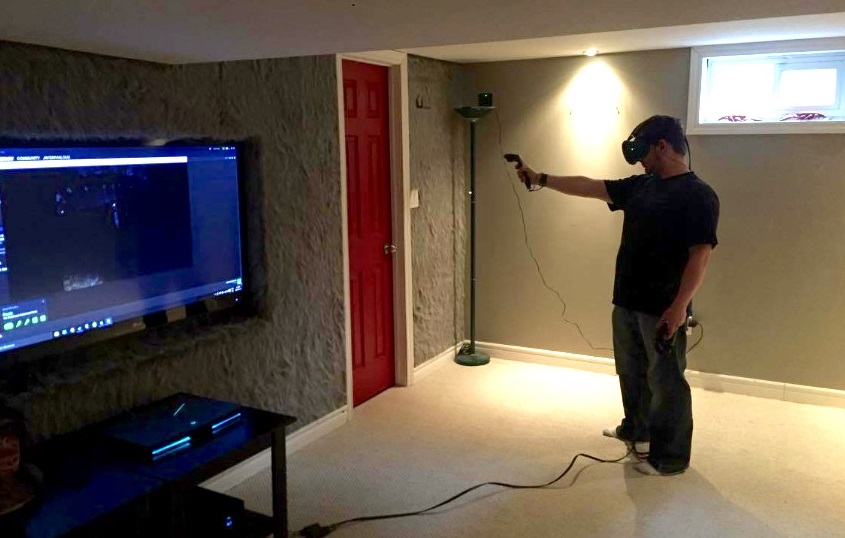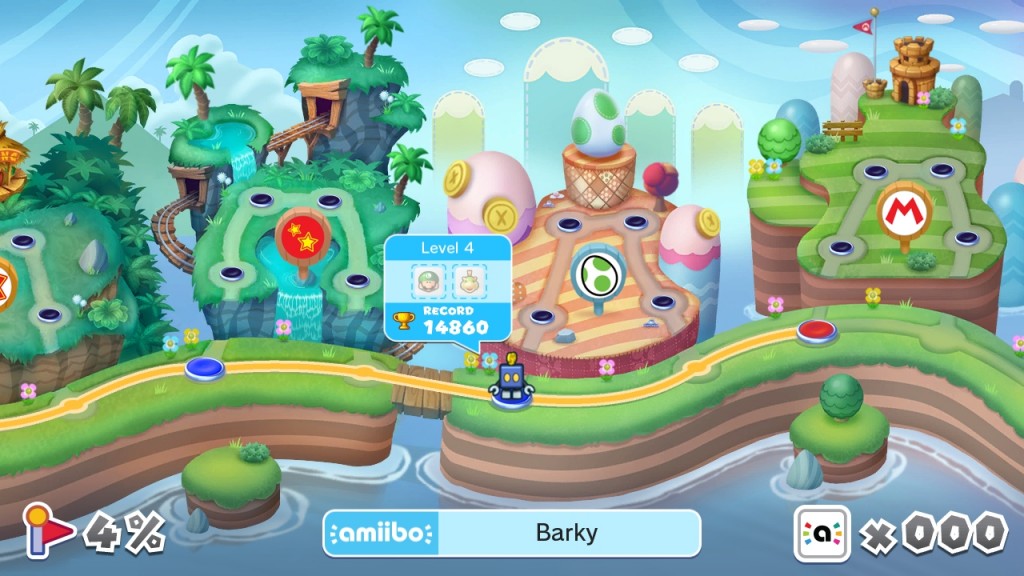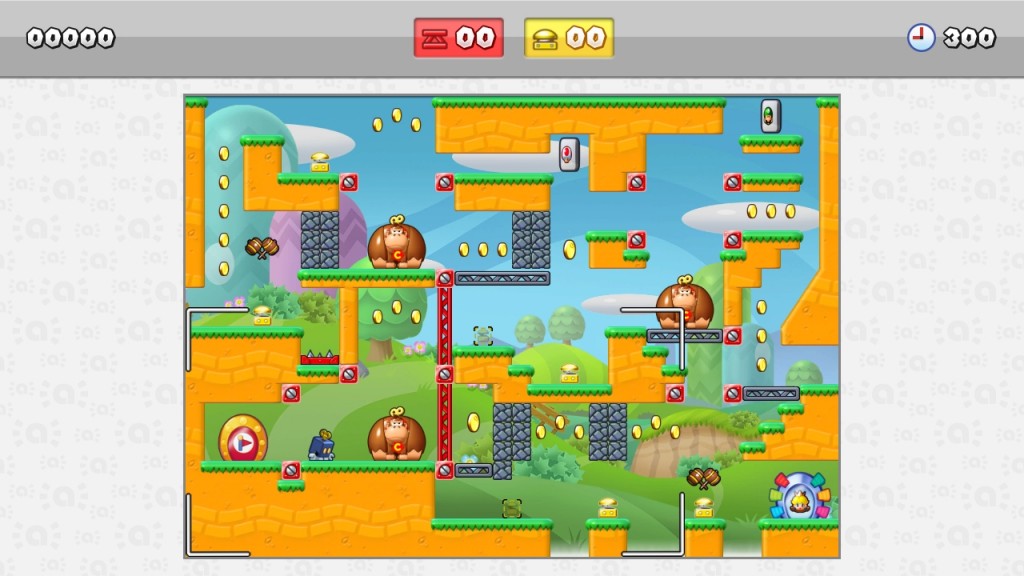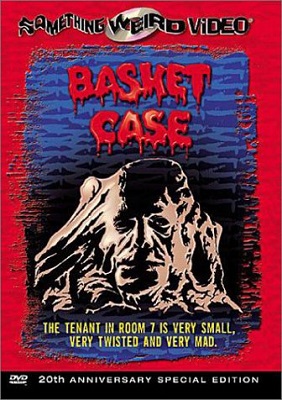I can’t believe that I did something noteworthy and forgot to mention it for… three days.
Last weekend, I got the chance to play with an HTC Vive for a few hours. My cousin’s husband had pre-ordered one, and it arrived on Friday so he invited me and my brother to come over and check it out.
Now, I have been pretty staunchly apathetic about VR gaming. Not because it doesn’t appeal to me for any particular reason, but simply because I don’t want to care about it. I really don’t need to get dragged down that rabbit hole. Alas, a man can only remain wilfully ignorant for so long, and it’s easy to break down when the Vive’s gaming experience is unbelievably cool
First off, you really have no idea what it’s like until you’re in there. It really is like being sucked into another world. A world where you’re bashing into non-existent walls and ceilings because you’re way too absorbed in the VR experience, but another world no less. If you plug in earbuds as well, you’re as good as dead to the real world. It is amazingly immersive, and I actually felt really odd every time I took off the headset and returned to Earth.
The problem, of course, lies in the fact that you need a huge amount of real-world space to use the thing properly. The sensors measure out your range of real-world movement, which creates an in-game box in which you can flail around freely. You can then move said box around the larger game world via a process called “blinking,” which is far too hard to describe concisely, so I won’t even try. We were playing in a fairly small corner of a basement, and while it was workable, I can’t help but feel that a larger field of movement would have enhanced my experience. The less blinking around, the better.
I started off in a simple tutorial (hosted by a not-Wheatley spheroid robot) that showed me where all the buttons were, and allowed me to shoot lasers, fire off confetti blasts, and inflate balloons to my heart’s content. It was simple and cute. Then I moved into the Wii Sports of VR, Valve’s The Lab. I only played three of the eight available mini-games, but each really spoke to me in a different way.
First was Robot Repair, which puts you in a cute little office where you start by playing around with a few drawers and switches to get used to moving around and interacting in virtual space. Then an overhead door opens and one of the multiplayer robots from Portal 2 stumbles out, ostensibly in need of repair. This is where the “reality” part of virtual reality really started to shine.
When you see a huge robot lumbering at you unsteadily, even when you know it’s a pretend thing, you get the heck out of the way. It is an involuntary reaction, because even though this is all just images being beamed into your eyes through a crazy expensive headset, your brain is being tricked into thinking that it’s real. Of course, it got much, much worse when I failed to repair the robot. It fell apart, and then the office fell apart, giving way to a massive factory. Then GLaDOS (who is massive and terrifying; I nearly fell over when she appeared) came out of nowhere to harangue me, seal me in a cube and then smash me into a fine paste.
Robot Repair is defintely the best way for anyone to experience VR for the first time. I’ve embedded a video of it below, but it loses a lot when you aren’t completely immersed.
I moved on to another mini-game called Slingshot, which was more or less Angry Birds, only viewed from the slingshot’s perspective. You load up these spheres, and then try to launch them to break as many boxes as possible. Red boxes explode, and blue boxes give you another sphere. Oh, and also, every sphere talks to you while you’re aiming, and they all have unique personalities. I found it very difficult to figure out where I was aiming, and generally had to launch one sphere as a baseline, and then adjust my shot with a second and possibly third sphere. I didn’t do great, but my brother absolutely killed it.
The last mini-game that I played in The Lab was Longbow. It is a simple tower defense game, where you’re standing on a castle wall, and you have only a bow and arrow to defend against adorable little silhouette invaders. I got really into this one, and by the second wave I was firing arrow after arrow like a madman (though I wasn’t a great shot). There are also little torches off to your sides so that you can shoot flaming arrows. I could see myself playing this one until I had achieved absolute mastery.

Next, I tried out a game called The Brookhaven Experiment. It is incredibly simple and incredibly familiar. You stand in the middle of a dark field, and then spin around and shoot zombies as they stumble towards you. It would be boring as all heck in any other situation, but actually being in the game made it all the more thrilling and intense. It took me a while to get used to aiming, because your gun swivels around realistically, instead of being aimed perfectly straight ahead like in every other game. So I had to learn to line up the sights to make accurate shots.
Once I figured that out though, it got really easy. Zombies go down from one good headshot, though big zombies take three or so. You also get a flashlight to help cut through the darkness, though it does have limited batteries. Like Longbow, I got really into this one, and learned to hold my flashlight under my gun, at once illuminating the area in front of me and steadying my shots. By the fourth wave, I had stopped bothering to use the flashlight at all.
It is a really easy and simple game, but the true thrill comes when you let zombies get too close. Again, even though it’s obviously fake, when you turn around to a zombie all up in your biz, your heart rate quickens and you do start to tense up. On more than one occasion I actually did fall backwards because my body was simply reacting to get me out of what it perceived as harm’s way.
The last game I played was The Gallery – Episode 1: Call of the Starseed. It has a terrible name, but it was a very cool game. The Gallery was very different from the other two games: it was a legitimate adventure games with all sorts of random junk to pick up and puzzles to solve. I wasted a lot of time just wandering around interacting with things to see what they could do (never very much), and mostly just enjoyed drinking in the atmosphere.
There isn’t a lot else to say about it, because it’s very short and there isn’t a lot that you can actually do, but it is a really cool glimpse into the future of VR. I’ll really be sold on this when they start making games where you can interact more deeply with the world and objects can do more than one scripted action. What I’m looking for is just a big virtual toybox, really.
Overall, I was incredibly impressed with the Vive. It delivers a truly unique, amazing experience. The biggest problem with it is that it’s got a massive barrier for entry. The price tag ($1,300, not including high-end gaming PC) is enough to make one queasy, and then there’s the need for an entire room devoted to the thing. It’s a very cool new technology, but it’s going to be a very difficult thing to introduce into the mainstream. The costs of getting and using the Vive could easily cause it to become an even shorter-lived success story than motion controls.
I really do look forward to seeing what people come up with when they start making really high quality games for VR, but as it is, there’s nothing that really makes it a must-have toy. Aside from bragging rights, I guess. Having experienced it first-hand, I’ve definitely been converted into a believer, but it’s going to be a while before I literally buy into virtual reality gaming.








